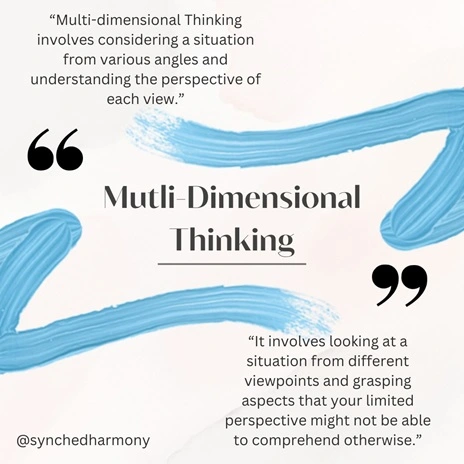Many people make the most important decisions in their lives without careful thought and consideration. Many of us have regretted the decisions made by us in the past. We often feel that we made hasty decisions, only to regret them later. But were you able to realize why those decisions went wrong?
The current situation in life is an outcome of the decisions that were made earlier. Well, this article isn’t focusing on decision-making, however, it will be a deep dive into an important aspect of decision-making that can significantly influence the outcome of your decision, which is Multidimensional thinking.
What is Multidimensional Thinking?
Referring to an article from St. Thomas University, Multidimensional thinking is a form of higher-level thinking where we take a topic or piece of information, and view it from various perspectives or dimensions to gain an overall understanding from various angles.
From the context of synched harmony, Multidimensional thinking involves considering a situation from diverse angles and understanding the perspectives of each view. It requires looking at situations from different viewpoints and grasping aspects that your limited perspective about a particular situation might not be able to comprehend otherwise. It requires understanding the context more comprehensively and comprehending the relationship between different perspectives.

Many people might confuse multidimensional thinking with knowing others’ perspectives. Still, I want to clarify to the audience that there is a slight difference between the two as knowing other’s perspectives is about listening to their thoughts and views without judging or deriving any inferences from them directly. At the same time, Multidimensional thinking requires deep thinking from different lenses and perspectives to uncover the root cause of the problem.
Quick Tip:
If you want to gain knowledge about perspective and mindset, please feel free to read the links below:
Must Read: Understanding Other’s Perspective – 10 Valuable Benefits
Must Read: 4 Easy Tips to Understand Others Mindset
What is an example of Multidimensional thinking?
Let’s understand this with a real-life example. Imagine you find yourself caught in a conflict that doesn’t directly involve you—for instance, an internal family dispute or disagreement between two family members that occurred in your absence. Now, to ensure that this disagreement doesn’t escalate into a quarrel, it becomes essential to resolve the matter peacefully. However, when it comes to family members, resolving such issues is rarely as straightforward as it seems. This is because taking one person’s side might disappoint the other.

In such circumstances, it’s crucial to handle the situation thoughtfully. This involves listening carefully to both sides, understanding the situation from their perspectives, and then analyzing the matter thoroughly from all angles to uncover the root cause of the problem. Once the root cause is identified, you can propose a mutually agreeable solution, creating a win-win situation for both parties.
Other examples of Multidimensional Thinking:
- Designing a product often utilizes multidimensional thinking where one has to consider several aspects such as consumer requirements, technological limitations, raw material quality, etc. before making a decision.
- Addressing social and political issues requires considering scientific, economic, political, social, and technological dimensions.
- Setting and achieving SMART goals for personal development.
Must Read: 10 SMART Goals For Success in 2025
Quick Tip:
Multidimensional thinking is a higher-level cognitive process that requires critical deep thinking. For effective deep thinking, it is essential to be in a calm and distraction-free environment. To engage in multidimensional thinking, having a pen and paper at hand is crucial, as it allows you to jot down your observations and structure your thoughts systematically.
Multidimensional Thinking Techniques?
Thinking from several lenses is a complex process, and it’s not something you can grasp in one go. It can take several days or even weeks, and having a calm demeanor and a positive mindset are crucial aspects of it. You can approach Multidimensional thinking in the following ways:

- Brainstorming: Brainstorming is a good way to trigger multidimensional thinking. However, it’s important to understand that you may not want to brainstorm ideas with those directly involved in the conflict. Instead, you should brainstorm with someone who has no involvement with the people involved in the conflict and who can provide unbiased opinions about the situation.
- Perspective-Taking: Perspective-taking can also trigger multidimensional thinking where you first listen to the viewpoints of others and then consider them from different scenarios and perspectives to help you gain a better understanding of the overall situation.
- Mind Mapping: With mind mapping, you visualize the situation in your mind and then try to fit all the scenarios in place accordingly. This allows you to think in various ways and helps you frame your perspective about that situation. Mind mapping is all about your thoughts, which can change after learning about the viewpoints of others.
- Scenario Analysis: Scenario analysis is about imagining different scenarios connected to the situation and then deeply contemplating each scenario to form your perspective on it. For instance, in a particular scenario, you think about what happened, why it happened, what triggered it, and what potential consequences could arise from it.
- Cross-disciplinary Insights: With the help of cross-disciplinary insights, you can utilize knowledge from other fields to foster multi-dimensional thinking. For instance, by learning about the psychology of human minds, you can approach problems with a new perspective where you will be in a better position to handle people’s mindsets and behavior.
- Expert Advice: Consulting with experts in the field or individuals with relevant experience can also help gain diverse perspectives. They can provide guidance that others might not be able to, and they can help focus your attention on aspects that you might not have thought of yourself.
- Time dimension Analysis: In time dimension analysis, you attempt to understand how any problem or situation has evolved. Also, you try to comprehend when it originated first and how far it has escalated. This helps you recognize patterns that might have been observed beforehand which are of repeating nature that could also be the potential root cause of the issue.
- Risk and Benefits Evaluation: In a risk vs. benefit analysis, you assess the potential risks and benefits of a decision before making it. It’s essential to thoroughly understand all aspects so that you’re aware of the associated benefits of the choice you’re about to make and the potential risks it entails.
Multidimensional Thinking – How Do You Think From Different Angles?
From my personal experience, while thinking from various angles, it’s more important for me to understand first why someone reacted in such a manner, instead of focusing on what they did wrong. Listening to other’s perspectives can uncover a few valid arguments that need to be addressed first.
Multidimensional thinking makes you go beyond your narrow perspective and consider different dimensions of thought. You will be able to contemplate and understand scenarios that might not be feasible in an ideal case. For example, in case of a family dispute, you will empathize with the pain of others and consider possible solutions to alleviate their pain. This approach has to be consistent with both parties, we need to think about whether it is possible to move forward together or not.
- Multidimensional thinking can’t just be done in your mind alone, you might need a pen and paper to write down your thoughts and ideas. It’s necessary to break down the problem and write down the pain areas of each problem segment. I personally follow this approach whenever I try to understand a problem and then if possible, I segregate the problem into smaller problems.
- Then, I list the perspectives and pain areas of impacted parties which provides a comprehensive view of the entire situation, making it easier to think about potential solutions.
- First and foremost, consider what can be done to allow things to resolve on its own without your direct involvement. This will result in the matter resolving itself, and you won’t have to bear unnecessary stress.
- Then, try to understand the scenarios they might be going through that led them to behave unusually due to inbuilt frustration. I also attempt to understand that even if we agree with their perspectives, would their actions still be justified?
- I also focus on what my perspective says after understanding everyone’s viewpoints. I use the multidimensional thinking techniques listed above to develop my perspective of the situation.
- The most important thing is to approach things with a positive mindset. Your goal isn’t to make things worse but to improve the overall situation. If you don’t think with a positive mindset, you won’t be able to find a proper solution. Thinking with a positive mindset also involves thinking beyond perspectives and considering long-term impacts, where your intention is not just to resolve the conflict for the short term, but to provide a permanent solution.
- Finally, after considering all the factors, it’s possible to arrive at a conclusion that might not be in everyone’s immediate favor. You might need to think about how to convince people individually so that the solution, which may seem wrong today, can prove to be beneficial in the long term.
Quick Tip:
Here’s a bonus piece of advice, When you’re unable to comprehend something on your own, discuss it with a trustworthy individual who has no common connection with the people involved in the conflict. There can be two benefits to this approach. First, you can have an open conversation with them, and second, they can offer an unbiased opinion about the issue.
Why it is important to look through different angles?
We often find ourselves in situations that are not directly related to us, and we get pulled into them involuntarily because the people involved in that situation are the ones that we care about.
- Using multidimensional thinking can gradually help clarify many things that often remain unknown. This allows you to take a step in the right direction to normalize conflicts and resolve them.
- Avoiding a complex situation every time can weaken the relationship bonds within the household, so it is necessary to handle them properly and maintain an equilibrium, it is important to understand how to tackle it in a manner that avoids unnecessary drama and resolves the problem peacefully which relates to a famous saying, “Kill the snake without breaking the stick.”
- Thinking from a different lens can expose several truths that may uncover hidden aspects of the problem and the root cause of the situation. The approach of multidimensional thinking is based on a thorough understanding of the situation without any biases involved. The ability to listen to others and comprehend things is a skill that not everyone possesses.
- Listening requires patience on your part, and it is equally important to refrain from asking too many questions while listening to others. Simply listen to them and allow them to express their feelings and emotions. When you actively listen and grasp others’ true perspectives, your ability to think in the right direction improves. You need to determine the direction in which you want to align your thinking and your focus is to bring peace and restore harmony, so whatever you think, it should be aligned with this objective.
Conclusion
To conclude, multidimensional thinking is an important factor that influences decision-making and plays a huge role in resolving relationship conflicts. There are various ways of thinking from different angles and the most common one is perspective-taking. In the end, approaching the problem with a positive mindset and having a thorough understanding of the situation can help in bringing balance to relationship equilibrium and achieving synced harmony.
If you like this article share it with others and FOLLOW Synched Harmony to join our vibrant community for daily inspiration!

3 thoughts on “Multidimensional Thinking – A Powerful Guide to Problem-Solving”